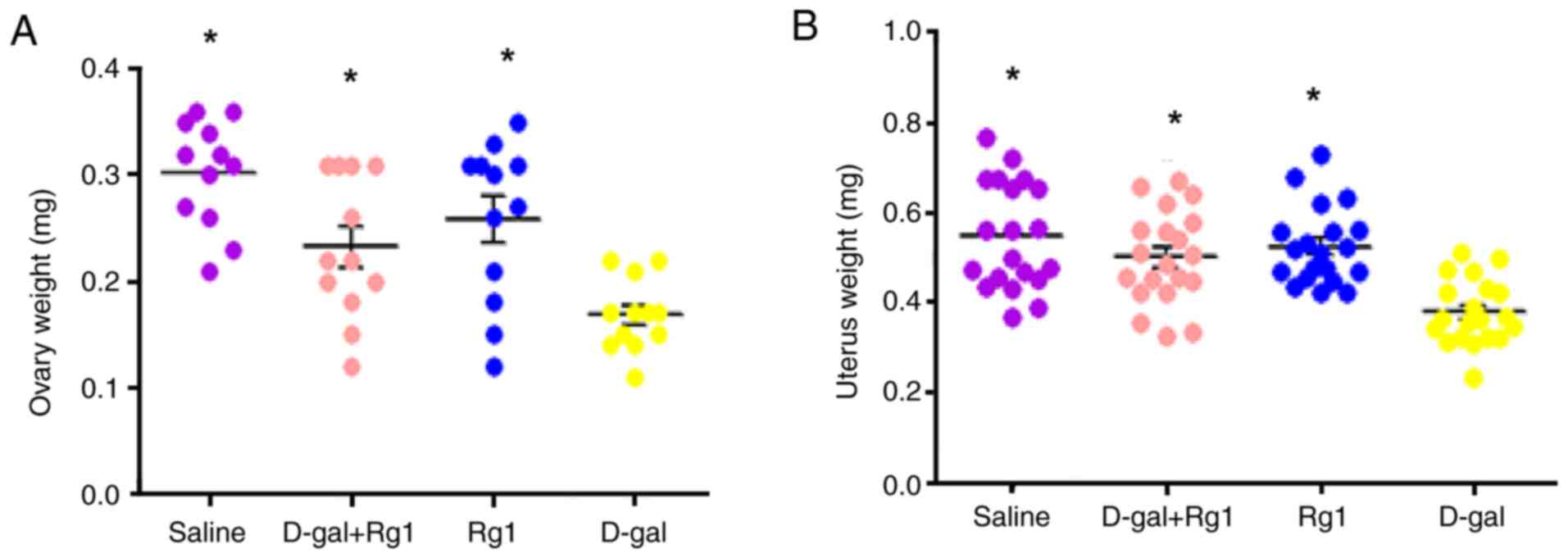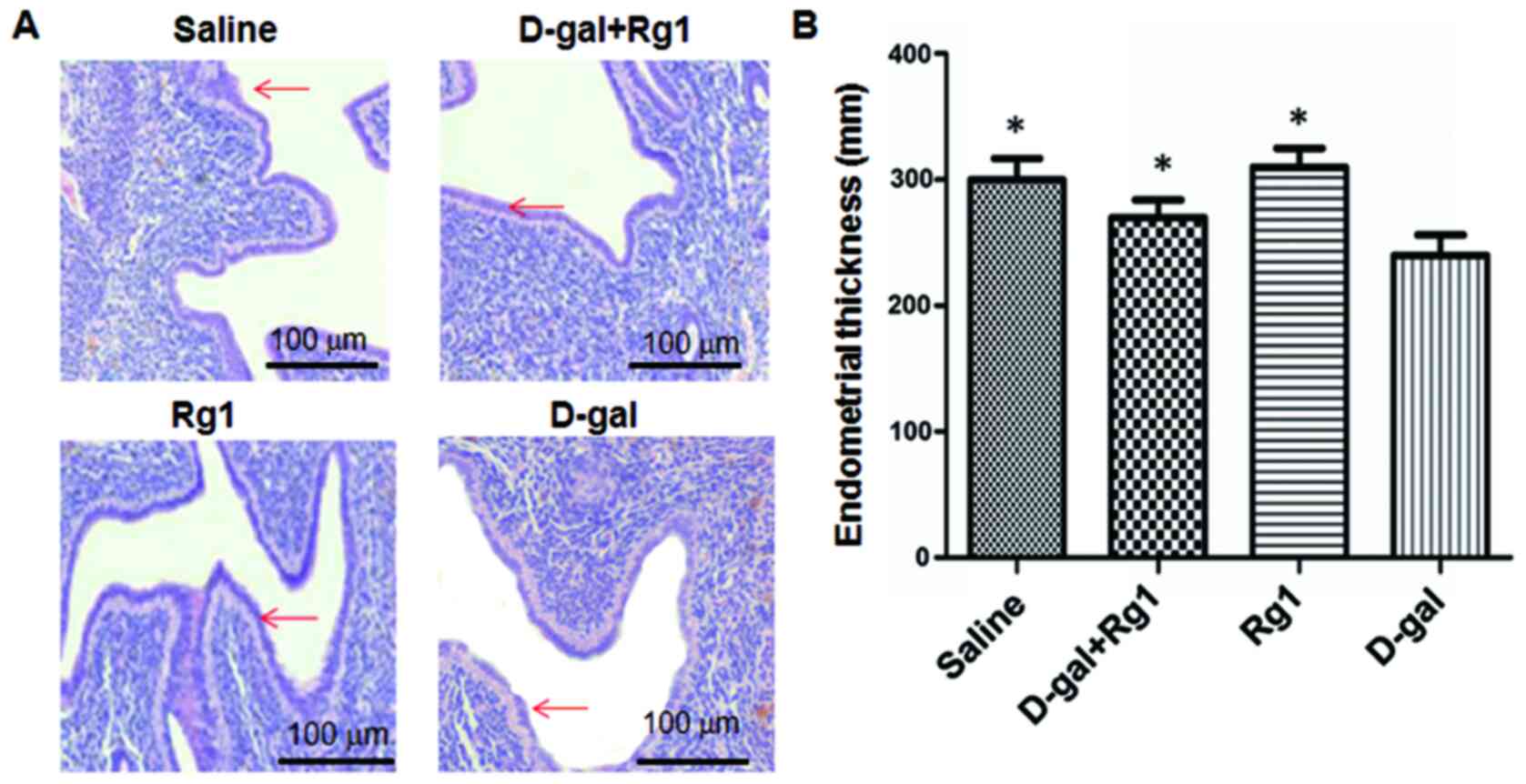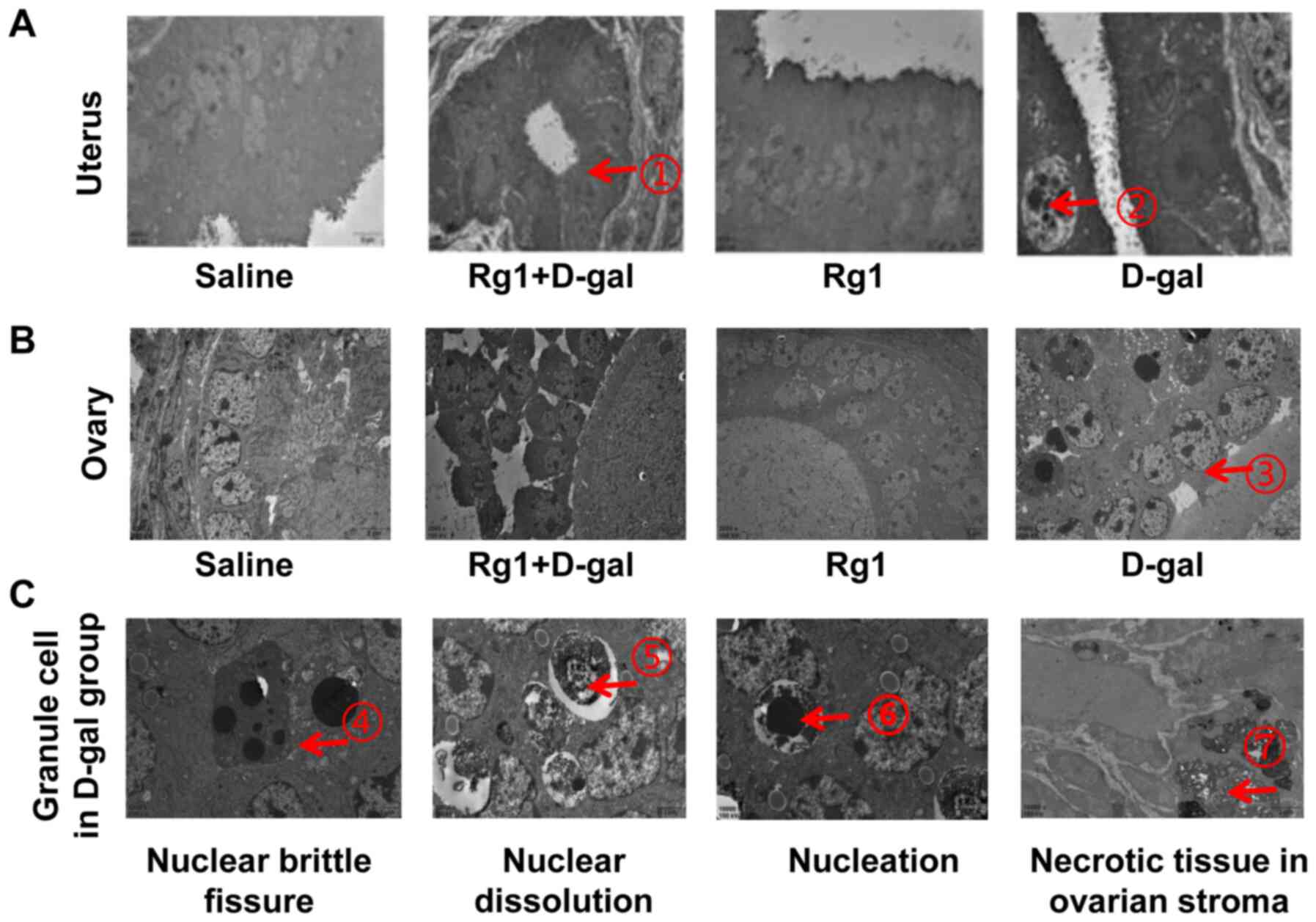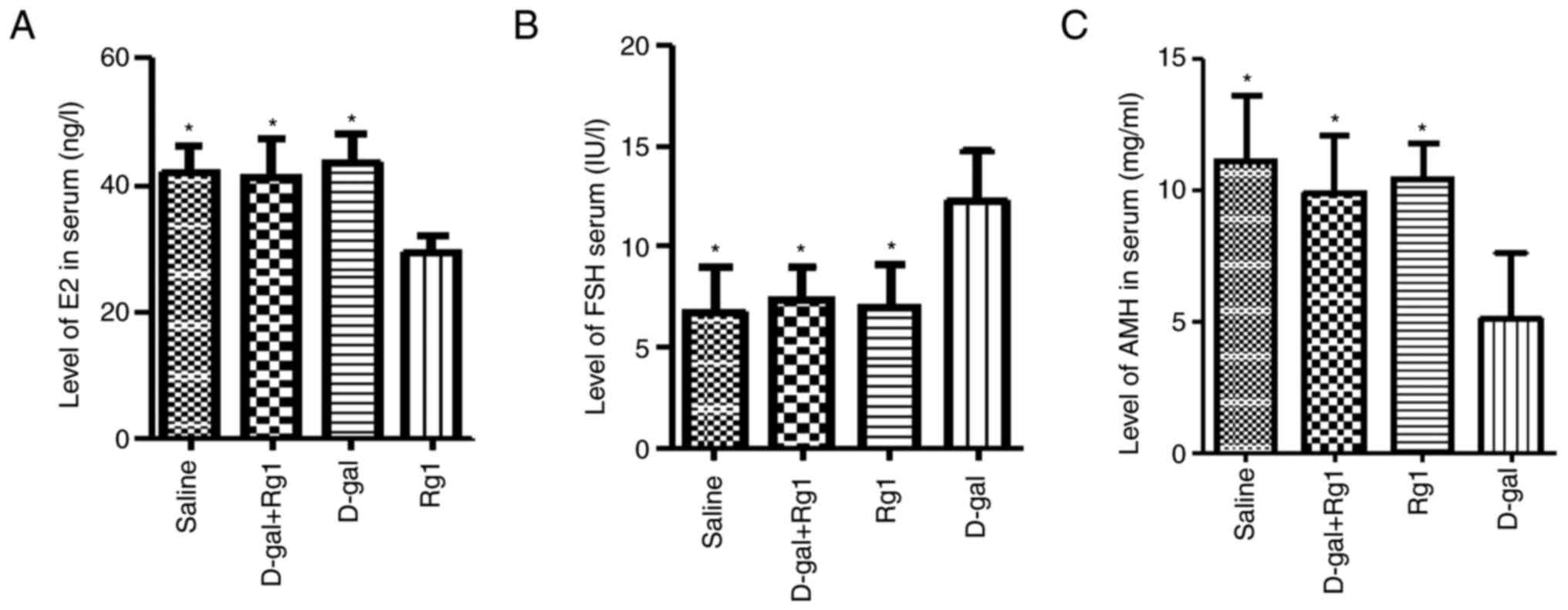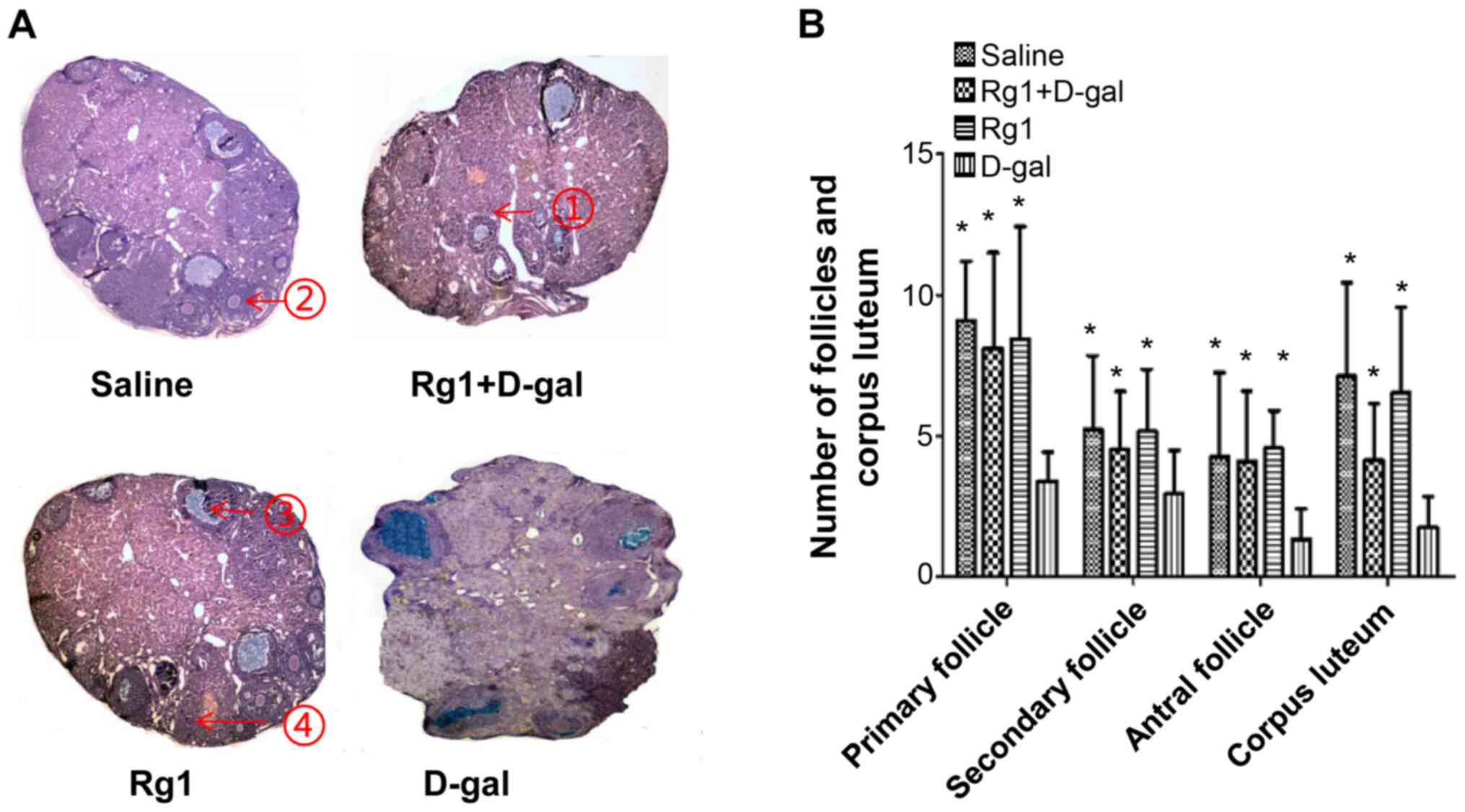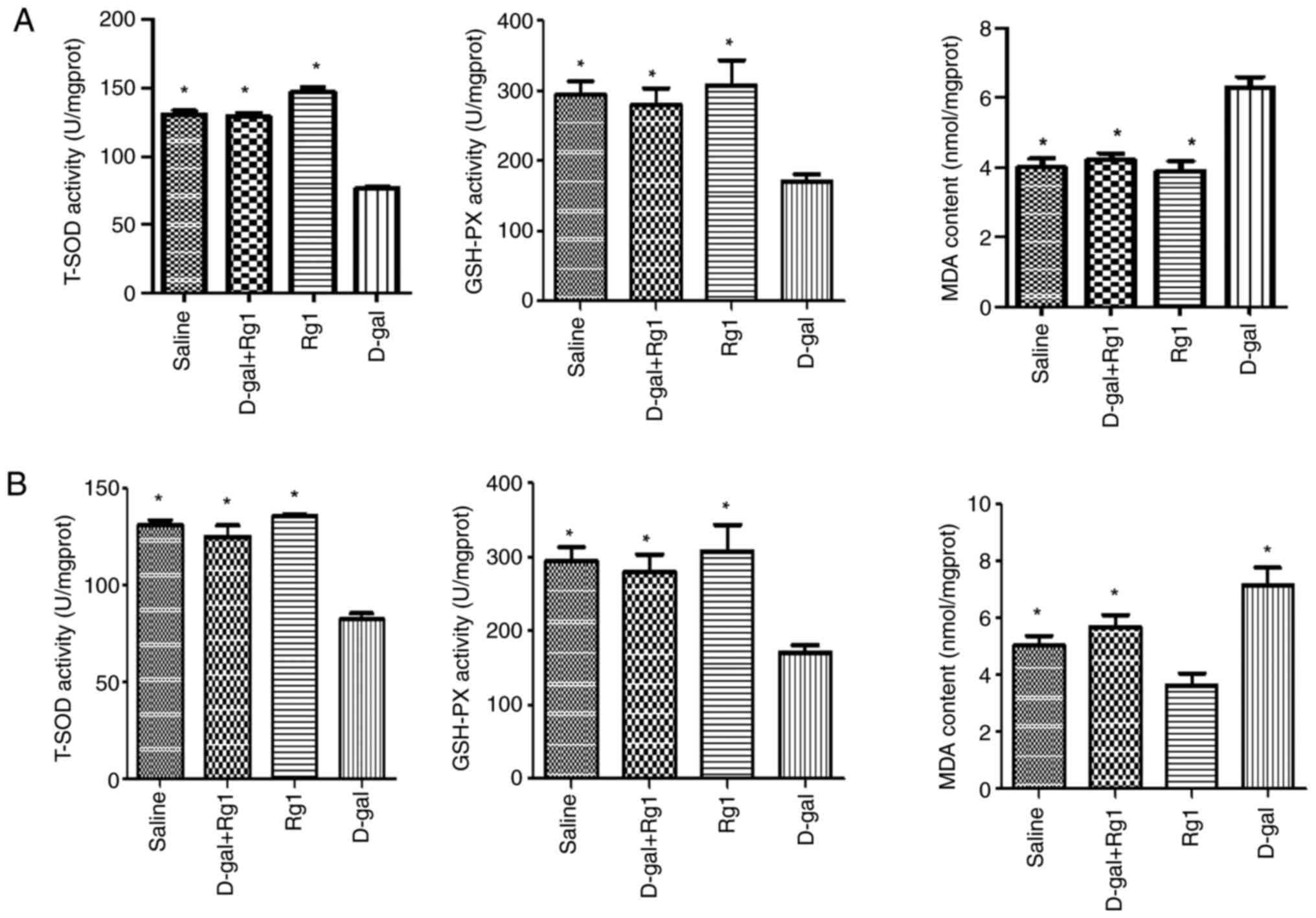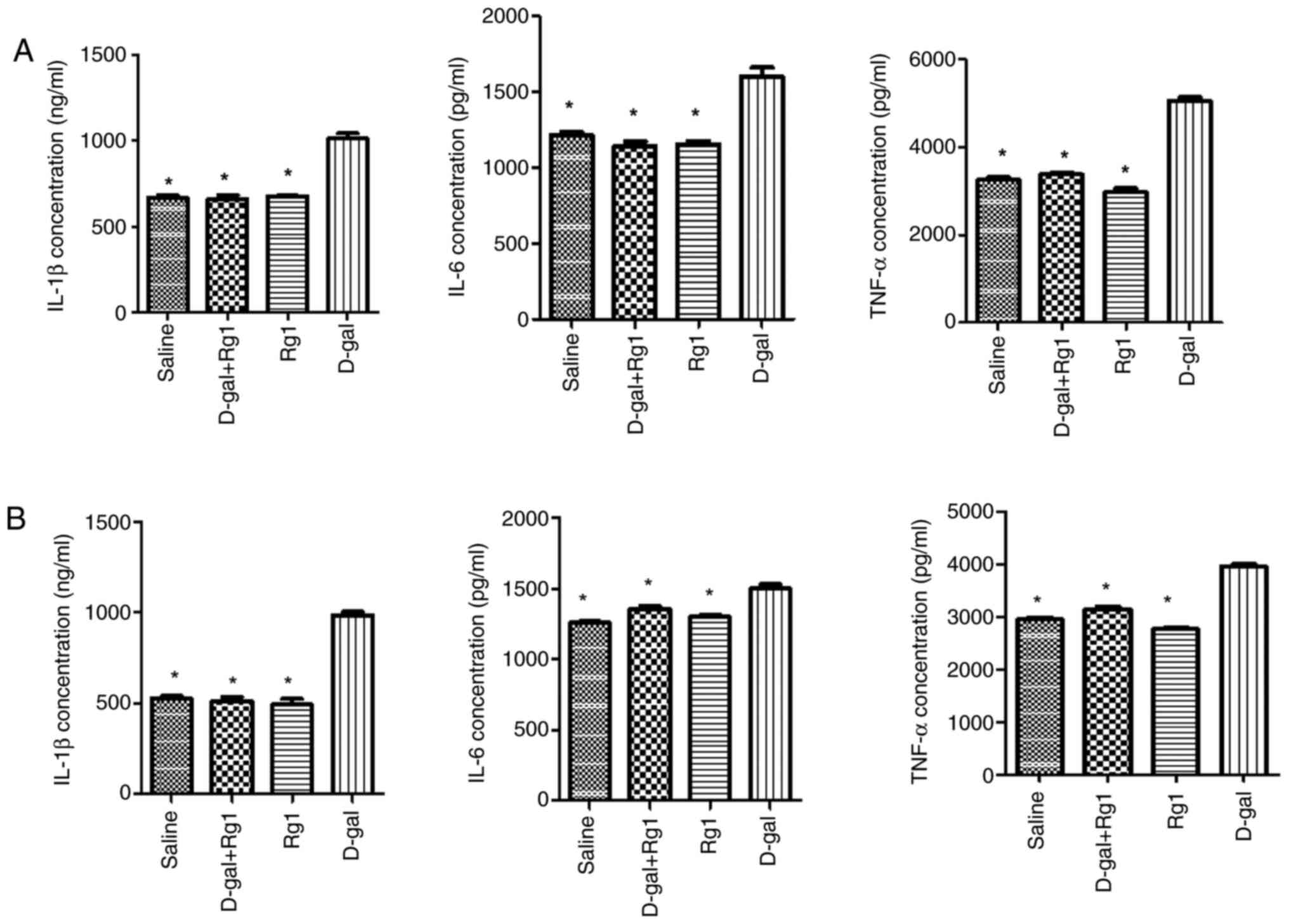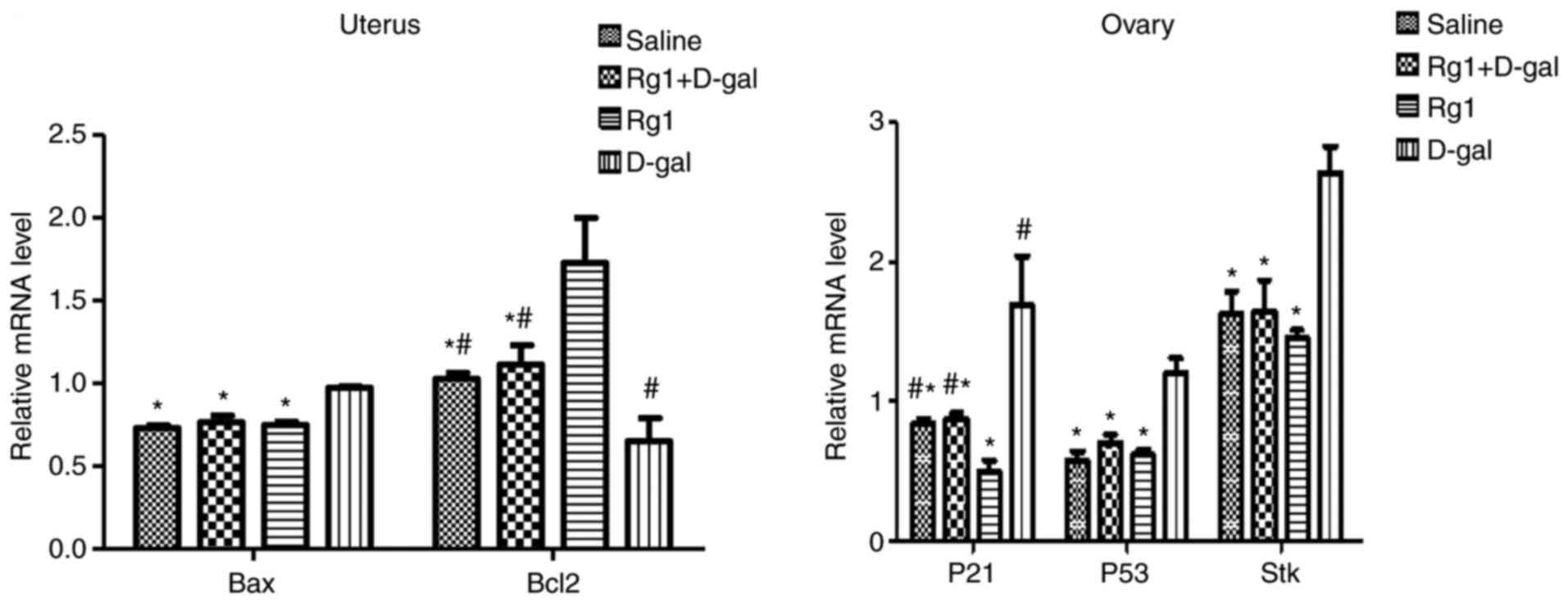|
1
|
Rossetti R, Ferrari I, Bonomi M and
Persani L: Genetics of primary ovarian insufficiency. Clin Genet.
91:183–198. 2017. View Article : Google Scholar : PubMed/NCBI
|
|
2
|
Laven JS: Primary ovarian insufficiency.
Semin Reprod Med. 34:230–234. 2016. View Article : Google Scholar : PubMed/NCBI
|
|
3
|
Qin C, Chen Y, Lin Q, Yao J, Wu W and Xie
J: The significance of polymorphism and expression of oestrogen
metabolism-related genes in Chinese women with premature ovarian
insufficiency. Reprod Biomed Online. 35:609–615. 2017. View Article : Google Scholar : PubMed/NCBI
|
|
4
|
Huang Y, Hu C, Ye H, Luo R, Fu X, Li X,
Huang J, Chen W and Zheng Y: Inflamm-aging: A new mechanism
affecting premature ovarian insufficiency. J Immunol Res.
2019:80698982019. View Article : Google Scholar : PubMed/NCBI
|
|
5
|
European Society for Human Reproduction
and Embryology (ESHRE) Guideline Group on POI, ; Webber L, Davies
M, Anderson R, Bartlett J, Braat D, Cartwright B, Cifkova R, de
Muinck Keizer-Schrama S, Hogervorst E, et al: ESHRE guideline:
Management of women with premature ovarian insufficiency. Hum
Reprod. 31:926–937. 2016. View Article : Google Scholar : PubMed/NCBI
|
|
6
|
Soman M, Huang LC, Cai WH, Xu JB, Chen JY,
He RK, Ruan HC, Xu XR, Qian ZD and Zhu XM: Serum androgen profiles
in women with premature ovarian insufficiency: A systematic review
and meta-analysis. Menopause. 26:78–93. 2019. View Article : Google Scholar : PubMed/NCBI
|
|
7
|
Vujović S, Ivovic M, Tančić-Gajić M,
Marina L, Ljubic A, Dragojević-Dikić S and Genazzani AR:
Endometrium receptivity in premature ovarian insufficiency-how to
improve fertility rate and predict diseases? Gynecol Endocrinol.
34:1011–1015. 2018. View Article : Google Scholar : PubMed/NCBI
|
|
8
|
Patel H, Arruarana V, Yao L, Cui X and Ray
E: Effects of hormones and hormone therapy on breast tissue in
transgender patients: A concise review. Endocrine. 68:6–15. 2020.
View Article : Google Scholar : PubMed/NCBI
|
|
9
|
Zhu C, Wang Y, Liu H, Mu H, Lu Y, Zhang J
and Huang J: Oral administration of Ginsenoside Rg1 prevents
cardiac toxicity induced by doxorubicin in mice through
anti-apoptosis. Oncotarget. 8:83792–83801. 2017. View Article : Google Scholar : PubMed/NCBI
|
|
10
|
Zhu J, Mu X, Zeng J, Xu C, Liu J, Zhang M,
Li C, Chen J, Li T and Wang Y: Ginsenoside Rg1 prevents cognitive
impairment and hippocampus senescence in a rat model of
D-galactose-induced aging. PLoS One. 9:e1012912014. View Article : Google Scholar : PubMed/NCBI
|
|
11
|
Yang N, Zhou B, Wang Y, Li Y, Liu J, Li P,
Yang N, Zhou B, Wang Y, et al: Research progress of the biological
activity of the ginsenoside Rg. Chinese J Traditional Chinese Med.
33:1463–1465. 2018.(In Chinese).
|
|
12
|
Tang F, Lu M, Yu L, Wang Q, Mei M, Xu C,
Han R, Hu J, Wang H and Zhang Y: Inhibition of TNF-α-mediated NF-κB
activation by ginsenoside Rg1 contributes the attenuation of
cardiac hypertrophy induced by abdominal aorta coarctation. J
Cardiovasc Pharmacol. 68:257–264. 2016. View Article : Google Scholar : PubMed/NCBI
|
|
13
|
Lee HY, Park SH, Chae SW, Soung NK, Oh MJ,
Kim JS, Kim YO and Chae HJ: Aqueous ginseng extract has a
preventive role in RANKL-induced osteoclast differentiation and
estrogen deficiency-induced osteoporosis. J Functional Foods.
13:192–203. 2015. View Article : Google Scholar
|
|
14
|
Cui Y, Shu XO, Gao YT, Cai H, Tao MH and
Zheng W: Association of ginseng use with survival and quality of
life among breast cancer patients. Am J Epidemiol. 163:645–653.
2006. View Article : Google Scholar : PubMed/NCBI
|
|
15
|
Ryan J, Scali J, Carriere I, Ritchie K and
Ancelin ML: Hormonal treatment, mild cognitive impairment and
Alzheimer's disease. Int Psychogeriatr. 20:47–56. 2008. View Article : Google Scholar : PubMed/NCBI
|
|
16
|
Zhao E and Mu Q: Phytoestrogen biological
actions on Mammalian reproductive system and cancer growth. Sci
Pharm. 79:1–20. 2011. View Article : Google Scholar : PubMed/NCBI
|
|
17
|
Cheng Y, Shen LH and Zhang JT:
Anti-amnestic and anti-aging effects of ginsenoside Rg1 and Rb1 and
its mechanism of action. Acta Pharmacol Sin. 26:143–149. 2005.
View Article : Google Scholar : PubMed/NCBI
|
|
18
|
Li J, Cai D, Yao X, Zhang Y, Chen L, Jing
P, Wang L and Wang Y: Protective effect of ginsenoside Rg1 on
hematopoietic stem/progenitor cells through attenuating oxidative
stress and the Wnt/β-Catenin signaling pathway in a mouse model of
d-Galactose-induced aging. Int J Mol Sci. 17:8492016. View Article : Google Scholar
|
|
19
|
He L: Establishment of D-gal induced
premature ovarian failure animal model. Proc Clin Med. 25:762–764.
2016.(In Chinese).
|
|
20
|
Huang JL, Yu C, Su M, Yang SM, Zhang F,
Chen YY, Liu JY, Jiang YF, Zhong ZG, et al: Probucol, a
“non-statin” cholesterol-lowering drug, ameliorates D-galactose
induced cognitive deficits by alleviating oxidative stress via
Keap1/Nrf2 signaling pathway in mice. Aging (Albany NY).
11:8542–8555. 2019. View Article : Google Scholar : PubMed/NCBI
|
|
21
|
Thakur M, Shaeib F, Khan SN, Kohan-Ghadr
HR, Jeelani R, Aldhaheri SR, Gonik B and Abu-Soud HM: Galactose and
its metabolites deteriorate metaphase II mouse oocyte quality and
subsequent embryo development by disrupting the spindle structure.
Sci Rep. 7:2312017. View Article : Google Scholar : PubMed/NCBI
|
|
22
|
Banerjee S, Chakraborty P, Saha P,
Bandyopadhyay SA, Banerjee S and Kabir SN: Ovotoxic effects of
galactose involve attenuation of follicle-stimulating hormone
bioactivity and up-regulation of granulosa cell p53 expression.
PLoS One. 7:e307092012. View Article : Google Scholar : PubMed/NCBI
|
|
23
|
Sozen B, Ozekinci M, Erman M, Gunduz T,
Demir N and Akouri R: Dehydroepiandrosterone supplementation
attenuates ovarian ageing in a galactose-induced primary ovarian
insufficiency rat model. J Assist Reprod Genet. 36:2181–2189. 2019.
View Article : Google Scholar : PubMed/NCBI
|
|
24
|
Kim EM, Jung CH, Kim J, Hwang SG, Park JK
and Um HD: The p53/p21 complex regulates cancer cell invasion and
apoptosis by targeting Bcl-2 family proteins. Cancer Res.
77:3092–3100. 2017. View Article : Google Scholar : PubMed/NCBI
|
|
25
|
Zińczuk J, Zaręba K, Guzińska-Ustymowicz
K, Kędra B, Kemona A and Pryczynicz A: p16, p21, and p53 proteins
play an important role in development of pancreatic intraepithelial
neoplastic. Ir J Med Sci. 187:629–637. 2018. View Article : Google Scholar : PubMed/NCBI
|
|
26
|
Ibnat N, Kamaruzman NI, Ashaie M and
Chowdhury EH: Transfection with p21 and p53 tumor suppressor
plasmids suppressed breast tumor growth in syngeneic mouse model.
Gene. 701:32–40. 2019. View Article : Google Scholar : PubMed/NCBI
|
|
27
|
Fujino T, Yokokawa R, Oshima T and
Hayakawa M: SIRT1 knockdown up-regulates p53 and p21/Cip1
expression in renal adenocarcinoma cells but not in normal
renal-derived cells in a deacetylase-independent manner. J Toxicol
Sci. 43:711–715. 2018. View Article : Google Scholar : PubMed/NCBI
|
|
28
|
Dmitrieva AI, Serebryakova VA, Rakitin SS,
Kudyakov LA, Novitskii VV, Yankovich KI and Sevostyanova NV: Study
of the association of polymorphisms of p53 and p21 with the risk of
development of stomach cancer. Bull Exp Biol Med. 164:95–98. 2017.
View Article : Google Scholar : PubMed/NCBI
|
|
29
|
Ramadan MA, Shawkey AE, Rabeh MA and
Abdellatif AO: Expression of P53, BAX, and BCL-2 in human malignant
melanoma and squamous cell carcinoma cells after tea tree oil
treatment in vitro. Cytotechnology. 71:461–473. 2019. View Article : Google Scholar : PubMed/NCBI
|
|
30
|
Cicero L, Fazzotta S, Palumbo VD, Cassata
G and Lo Monte AI: Anesthesia protocols in laboratory animals used
for scientific purposes. Acta Biomed. 89:337–342. 2018.PubMed/NCBI
|
|
31
|
Boivin GP, Bottomley MA, Schiml PA, Goss L
and Grobe N: Physiologic, behavioral, and histologic responses to
various euthanasia methods in C57BL/6NTac male mice. J Am Assoc Lab
Anim Sci. 56:69–78. 2017.PubMed/NCBI
|
|
32
|
Wang Q, Yin J, Wang S, Cui D, Lin H, Ge M,
Dai Z, Xie L, Si J, Ma K, et al: Effects of activin A and its
downstream ERK1/2 in oxygen and glucose deprivation after
isoflurane-induced postconditioning. Biomed Pharmacother.
84:535–543. 2016. View Article : Google Scholar : PubMed/NCBI
|
|
33
|
Livak KJ and Schmittgen TD: Analysis of
relative gene expression data using real-time quantitative PCR and
the 2(-Delta Delta C(T)) method. Methods. 25:402–408. 2001.
View Article : Google Scholar : PubMed/NCBI
|
|
34
|
Saat N, Risvanli A, Dogan H, Onalan E,
Akpolat N, Seker I and Sahna E: Effect of melatonin on torsion and
reperfusion induced pathogenesis of rat uterus. Biotech Histochem.
94:533–539. 2019. View Article : Google Scholar : PubMed/NCBI
|
|
35
|
Chen MJ, Chou CH, Shun CT, Mao TL, Wen WF,
Chen CD, Chen SU, Yang YS and Ho HN: Iron suppresses ovarian
granulosa cell proliferation and arrests cell cycle through
regulating p38 mitogen-activated protein kinase/p53/p21 pathway.
Biol Reprod. 97:438–448. 2017. View Article : Google Scholar : PubMed/NCBI
|
|
36
|
da Costa JP, Vitorino R, Silva GM, Vogel
C, Duarte AC and Rocha-Santos T: A synopsis on aging-theories,
mechanisms and future prospects. Ageing Res Rev. 29:90–112. 2016.
View Article : Google Scholar : PubMed/NCBI
|
|
37
|
Flatt T and Partridge L: Horizons in the
evolution of aging. BMC Biol. 16:932018. View Article : Google Scholar : PubMed/NCBI
|
|
38
|
Sun C, Fan S, Wang X, Lu J, Zhang Z, Wu D,
Shan Q and Zheng Y: Purple sweet potato color inhibits endothelial
premature senescence by blocking the NLRP3 inflammasome. J Nutr
Biochem. 26:1029–1040. 2015. View Article : Google Scholar : PubMed/NCBI
|
|
39
|
Sullivan SD, Sarrel PM and Nelson LM:
Hormone replacement therapy in young women with primary ovarian
insufficiency and early menopause. Fertil Steril. 106:1588–1599.
2016. View Article : Google Scholar : PubMed/NCBI
|
|
40
|
Riegle van West K, Stinear C and Buck R:
The effects of poi on physical and cognitive function in healthy
older adults. J Aging Phys Act. Nov 8–2018.(Online ahead of print).
PubMed/NCBI
|
|
41
|
Sundaresan NR, Saxena VK, Sastry KV,
Nagarajan K, Jain P, Singh R, Anish D, Ravindra PV, Saxena M and
Ahmed KA: Cytokines and chemokines in postovulatory follicle
regression of domestic chicken (Gallus gallus domesticus).
Dev Comp Immunol. 32:253–264. 2008. View Article : Google Scholar : PubMed/NCBI
|
|
42
|
He L, Ling L, Wei T, Wang Y and Xiong Z:
Ginsenoside Rg1 improves fertility and reduces ovarian pathological
damages in premature ovarian failure model of mice. Exp Biol Med
(Maywood). 242:683–691. 2017. View Article : Google Scholar : PubMed/NCBI
|
|
43
|
Mou Z, Huang Q, Chu SF, Zhang MJ, Hu JF,
Chen NH and Zhang JT: Antidepressive effects of ginsenoside Rg1 via
regulation of HPA and HPG axis. Biomed Pharmacother. 92:962–971.
2017. View Article : Google Scholar : PubMed/NCBI
|
|
44
|
Mo J, Zhou Y, Yang R, Zhang P, He B, Yang
J, Li S, Shen Z and Chen P: Ginsenoside Rg1 ameliorates palmitic
acid-induced insulin resistance in HepG2 cells in association with
modulating Akt and JNK activity. Pharmacol Rep. 71:1160–1167. 2019.
View Article : Google Scholar : PubMed/NCBI
|
|
45
|
Yan Z, Dai Y, Fu H, Zheng Y, Bao D, Yin Y,
Chen Q, Nie X, Hao Q, Hou D and Cui Y: Curcumin exerts a protective
effect against premature ovarian failure in mice. J Mol Endocrinol.
60:261–271. 2018. View Article : Google Scholar : PubMed/NCBI
|
|
46
|
Mullen RD, Ontiveros AE, Moses MM and
Behringer RR: AMH and AMHR2 mutations: A spectrum of reproductive
phenotypes across vertebrate species. Dev Biol. 455:1–9. 2019.
View Article : Google Scholar : PubMed/NCBI
|
|
47
|
Roness H and Meirow D: Fertility
preservation: Follicle reserve loss in ovarian tissue
transplantation. Reproduction. 158:F35–F44. 2019. View Article : Google Scholar : PubMed/NCBI
|
|
48
|
Warren L, Murawski M, Wilk K, Zieba DA and
Bartlewski PM: Suitability of antral follicle counts and
computer-assisted analysis of ultrasonographic and magnetic
resonance images for estimating follicular reserve in porcine,
ovine and bovine ovaries ex situ. Exp Biol Med (Maywood).
240:576–584. 2015. View Article : Google Scholar : PubMed/NCBI
|
|
49
|
Song D, Zhong Y, Qian C, Zou Q, Ou J, Shi
Y, Gao L, Wang G, Liu Z, Li H, et al: Human umbilical cord
mesenchymal stem cells therapy in cyclophosphamide-induced
premature ovarian failure rat model. Biomed Res Int.
2016:25175142016. View Article : Google Scholar : PubMed/NCBI
|
|
50
|
Liu Y, Li YJ and Wang L: Changes of
expression of p53-p21 in premature ovarian failure in fluorosis
female mice. Chongqing Med. 13:1712–1715. 2018.
|
|
51
|
Podfigurna-Stopa A, Czyzyk A, Grymowicz M,
Smolarczyk R, Katulski K, Czajkowski K and Meczekalski B: Premature
ovarian insufficiency: The context of long-term effects. J
Endocrinol Invest. 39:983–990. 2016. View Article : Google Scholar : PubMed/NCBI
|
|
52
|
He L: Preliminary study on animal model of
ovarian premature failure induced by d-galactose. Clin Med
Practice. 10:762–764. 2016.
|
|
53
|
Ali DE, Shah M, Ali A, Malik MO, Rehman F,
Badshah H, Ehtesham E and Vitale SG: Treatment with metformin and
combination of metformin plus pioglitazone on serum levels of IL-6
and IL-8 in polycystic ovary syndrome: A randomized clinical trial.
Horm Metab Res. 51:714–722. 2019. View Article : Google Scholar : PubMed/NCBI
|
|
54
|
Qin C, Yuan Z, Yao J, Zhu W, Wu W and Xie
J: AMH and AMHR2 genetic variants in Chinese women with primary
ovarian insufficiency and normal age at natural menopause. Reprod
Biomed Online. 3:311–318. 2014. View Article : Google Scholar
|
|
55
|
Thakur M, Feldman G and Puscheck EE:
Primary ovarian insufficiency in classic galactosemia: Current
understanding and future research opportunities. J Assist Reprod
Genet. 35:3–16. 2018. View Article : Google Scholar : PubMed/NCBI
|
|
56
|
Wang W, Wang Y, Wu J, Yang L and Liu Z:
Protective effects of electroacupuncture pretreatment on ovarian in
rats with premature ovarian insufficiency. Zhongguo Zhen Jiu.
38:405–411. 2018.(In Chinese). PubMed/NCBI
|
|
57
|
Yuan S, Wen J, Cheng J, Shen W, Zhou S,
Yan W, Shen L, Luo A and Wang S: Age-associated up-regulation of
EGR1 promotes granulosa cell apoptosis during follicle atresia in
mice through the NF-κB pathway. Cell Cycle. 15:2895–2905. 2016.
View Article : Google Scholar : PubMed/NCBI
|
|
58
|
Yang F, Pei R, Zhang Z, Liao J, Yu W, Qiao
N, Han Q, Li Y, Hu L, Guo J, et al: Copper induces oxidative stress
and apoptosis through mitochondria-mediated pathway in chicken
hepatocytes. Toxicol In Vitro. 54:310–316. 2019. View Article : Google Scholar : PubMed/NCBI
|
|
59
|
Falfushynska HI, Gnatyshyna LL, Deneha HV,
Osadchuk OY and Stoliar OB: Manifestations of oxidative stress and
molecular damages in ovarian cancer tissue. Ukr Biochem J.
87:93–102. 2015. View Article : Google Scholar : PubMed/NCBI
|
|
60
|
Zhang L, Kong XJ, Wang ZQ, Xu FS and Zhu
YT: A study on neuroprotective effects of curcumin on the diabetic
rat brain. J Nutr Health Aging. 20:835–840. 2016. View Article : Google Scholar : PubMed/NCBI
|
|
61
|
Biswas P, Mukhopadhyay A, Kabir SN and
Mukhopadhyay PK: High-protein diet ameliorates arsenic-induced
oxidative stress and antagonizes uterine apoptosis in rats. Biol
Trace Elem Res. 192:222–233. 2019. View Article : Google Scholar : PubMed/NCBI
|
|
62
|
Xie W, Zhou P, Sun Y, Meng X, Dai Z, Sun G
and Sun X: Protective effects and target network analysis of
ginsenoside Rg1 in cerebral ischemia and reperfusion injury: A
comprehensive overview of experimental studies. Cells. 7:2702018.
View Article : Google Scholar
|
|
63
|
Fan C, Song Q, Wang P, Li Y, Yang M and Yu
SY: Neuroprotective effects of ginsenoside-Rg1 against
depression-like behaviors via suppressing glial activation,
synaptic deficits, and neuronal apoptosis in rats. Front Immunol.
9:28892018. View Article : Google Scholar : PubMed/NCBI
|
|
64
|
Yang MZ, Li SG, et al: Effect of
ginsenosideRg3 on ageing of vascular smooth muscle cells and itsm
echanism. Heart BrainVessel Dis. 17:1079–1082. 2015.
|
|
65
|
Chen M, Zhang H, Zhang G, Zhong A, Ma Q,
Kai J, Tong Y, Xie S, Wang Y, Zheng H, et al: Targeting TPX2
suppresses proliferation and promotes apoptosis via repression of
the PI3k/AKT/P21 signaling pathway and activation of p53 pathway in
breast cancer. Biochem Biophys Res Commun. 507:74–82. 2018.
View Article : Google Scholar : PubMed/NCBI
|
|
66
|
Uxa S, Bernhart SH, Mages CFS, Fischer M,
Kohler R, Hoffmann S, Stadler PF, Engeland K and Müller GA: DREAM
and RB cooperate to induce gene repression and cell-cycle arrest in
response to p53 activation. Nucleic Acids Res. 47:9087–9103. 2019.
View Article : Google Scholar : PubMed/NCBI
|
|
67
|
Ma M, Chen XY, Li B and Li XT: Melatonin
protects premature ovarian insufficiency induced by tripterygium
glycosides: Role of SIRT1. Am J Transl Res. 9:1580–1602.
2017.PubMed/NCBI
|
|
68
|
Hussein MR: Apoptosis in the ovary:
Molecular mechanisms. Hum Reprod Update. 11:162–177. 2005.
View Article : Google Scholar : PubMed/NCBI
|
|
69
|
el-Deiry WS, Tokino T, Velculescu VE, Levy
DB, Parsons R, Trent JM, Lin D, Mercer WE, Kinzler KW and
Vogelstein B: WAF1, a potential mediator of p53 tumor suppression.
Cell. 75:817–825. 1993. View Article : Google Scholar : PubMed/NCBI
|
|
70
|
Harper JW, Adami GR, Wei N, Keyomarsi K
and Elledge SJ: The p21 Cdk-interacting protein Cip1 is a potent
inhibitor of G1 cyclin-dependent kinases. Cell. 75:805–816. 1993.
View Article : Google Scholar : PubMed/NCBI
|
|
71
|
Hussein MR, Haemel AK and Wood GS:
Apoptosis and melanoma: Molecular mechanisms. J Pathol.
199:275–288. 2003. View Article : Google Scholar : PubMed/NCBI
|
|
72
|
Hormozi M, Ghoreishi S and Baharvand P:
Astaxanthin induces apoptosis and increases activity of antioxidant
enzymes in LS-180 cells. Artif Cells Nanomed Biotechnol.
47:891–895. 2019. View Article : Google Scholar : PubMed/NCBI
|
|
73
|
Vartak SV, Iyer D, Santhoshkumar TR,
Sharma S, Mishra A, Goldsmith G, Srivastava M, Srivastava S, Karki
SS, Surolia A, et al: Novel BCL2 inhibitor, Disarib induces
apoptosis by disruption of BCL2-BAK interaction. Biochem Pharmacol.
131:16–28. 2017. View Article : Google Scholar : PubMed/NCBI
|
|
74
|
Rahmani M, Nkwocha J, Hawkins E, Pei X,
Parker RE, Kmieciak M, Leverson JD, Sampath D, Ferreira-Gonzalez A
and Grant S: Cotargeting BCL-2 and PI3K induces BAX-dependent
mitochondrial apoptosis in AML cells. Cancer Res. 78:3075–3086.
2018. View Article : Google Scholar : PubMed/NCBI
|
|
75
|
Mousa AM, Al-Fadhli AS, Rao MS and
Kilarkaje N: Gestational lead exposure induces developmental
abnormalities and up-regulates apoptosis of fetal cerebellar cells
in rats. Drug Chem Toxicol. 38:73–83. 2015. View Article : Google Scholar : PubMed/NCBI
|















